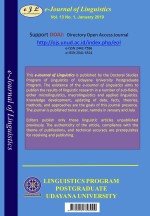Phonological Errors of Broca’s Aphasia: A Single Case Study of Neurolingusitics
Abstract
Abstract— Broca’s aphasic patients display language problems in initiating utterances with groping movements, multiple false attempts and self-correction resulting from a lesion to the third frontal convolution of the left hemisphere of the brain. This study describes the forms of sound impairment, types of errors and phonetic processing by a Balinese patient who suffered from non-fluent speech disorder. The results showed that KW’s speech performance was categorized severe. There were 0.80% phonological errors in word naming, 0.92% in picture naming, 0.87% in answering questions and 0.89% in oral reading. Of the three other types of errors, sound substitution errors mostly appeared in every phonological task. He made 65% sound substitutions, 20% sound distortions, 10% sound insertions and 5% omissions. Different speech stimulation could trigger sound inconsistency. The phonological errors occurred because there was not any appropriate coordination between phonological representation and phonetic realization due to the loss of linguistic message in Broca’s area.
Downloads
References
Arifuddin. 2010. Neurophsycolinguistics. Jakarta: Raja Grafindo Persada.
Bambini, V. 2012. Neurolinguistics. In J.O Otsman., J. Verschueren. Hands book of Pragmatics (pp.1- 29). John Benjamin Publishing Company, (Chapter 1)
Bastiaanse, R., & Zonneveld, V.R. 2004. Broca's aphasia, verbs and the mental lexicon. Brain and Language, 90, 198–202.
Benson, D. F. 1979. Aphasia, Alexia, and Agraphia. New York: Churchill Livingstone, New
York.
Buckingham, H.W., & Chrisman, S. S. 2008. Disorders of Phonetics and Phonology. In B. Stemmer, & H.A. Whitaker. Handbook of Neuroscience of Language (pp.127 – 136. London: Elsevier Ltd
Dell. S.G., Chang, F., & Griffin, Z.M. 1999. Connectionist Models of Language Production:
Lexical Access and Grammatical Encoding. Cognitive Science, 23 (4), 517-542.
Freemon. F.R. 1982. Classification of Aphasia, in Neurology of Aphasia (Kirsner S and
Freemon F.R eds) 36. Swetz & Zeitlinger B,V,Lisse
Gandour, J.T. 1998. Phonetics and Phonology. In B. Stemmer., H.A. Whitaker. Handbook of Neurolinguistics, (pp. 207 – 218). Indiana: Academic Press, (Chapter 13).
Gordon, B., & Ledoux K. (2008). Direct Electrical of Language Cortex. In B. Stemmer, & H.A. Whitaker. Handbook of Neuroscience of Language, (pp.105 – 113). London: Elsevier Ltd.
Hesketh, A., Adams, C., Nightingale, C., & Hall, R. (2000). Phonological Awareness Therapy and Articulatory Training Aprroaches for Children with Phonological Disorder: a Comparative Outcome Study. International Journal of language and Communication Disorders, 35 (3) 337-354.
Kemmerer, D. (2014). Neurolinguistics: Mind, Brain and Language. In K. Allan (Ed). The Routledge Handbook of Linguistics (pp. 1-14). New York: Routledge, (Chapter 1).
Kendal, D.L.,Conway, T., Rosenbek, J., Rothi, L.J. (2003). Phonological Rehabilitation of acquired Phonological Alexia. Aphasiology, 17 (11), 1073-1095.
Kohn, S.E. (1988). Phonological Prooduction Deficits in Aphasia. In H.A. Whitaker. Phonological Processes and Brain Mechanism, ed. (pp. 93 – 117). New York: SpringerVerlag.
Kusumoputro, S. (1992). Afasia: Gangguan Berbahasa. Jakarta: Balai Penerbit Fakultas Kedokteran, Universitas Indonesia
Ladefoged, P. (2001). Vowels and Consonants: Introduction to the Sounds of Language. Oxford: Blackwell Publishing Ltd
Ladefoged, P. (2003). Phonetic Data Analysis. Oxford: Blackwell Publishing Ltd
Lieberman, P.,& Blumstein, S.E. (1988). Speech Physiology, Speech Perception, and Accoustic Phonetics. New York: Cambridge University Press.
Marotta, G., Barbera, M., & Bongioanni, P. (2008). Prosody and Broca’s Aphasia: An Accoustic Analysis. On line Journal of Studi Linguistici e Filologici, 6. 79-98.
Musso, M., Weiller, C., Kiebel, S., Muller,S.P., Bulau,P & Rijntjes, M. (1999). Training-Induced Brain Plasticity in Aphasia. Brain, 122, 1781-1790.
Novick, J.M., Trueswell, J.C., Thompson, S., & Sharon, L. (2010): "Broca's Area and Language Processing: Evidence for the Cognitive Control Connection". Language and Linguistics Compass 4: 906–924.
Robson, J.,Marshall, J., Pring, T., & Chiat, S. (1998). Phonological Naming Therapy in Jargon Aphasia: Positive but Paradoxical Effects. Journal of the International Neuropsychological Society, 4, 675- 686.
Schane, S. B. (1992). Generative Phonology. San Diego: Prentice hall.Inc.
Schwartz, M.F., Dell, G.S., Martin, N., Gahl, S. (2006). A case-series test of the interactive two-step model of lexical access: Evidence from picture naming. Journal of Memory and Language, 54, 228–264
Sengkey, L.S, Pandeiroth. P. (2014). Mirror Therapy in Stroke Rehabilitation. Jounal Biomedic, 6 (2) 84-90.
Sidharta, P, & Dewanto, G. (1986). Anatomi susunan Saraf Pusat Manusia. Jakarta: PT. Dian Rakyat
Widjaja, H, Putra IBK, Nuartha, AABN. (2015). Neurorestorasi Pasca-CVA: Harapan Baru Penderita CVA. Continuing Medical Education, 42 (4), 257-261.

This work is licensed under a Creative Commons Attribution 4.0 International License.

This work is licensed under a Creative Commons Attribution 4.0 International License











